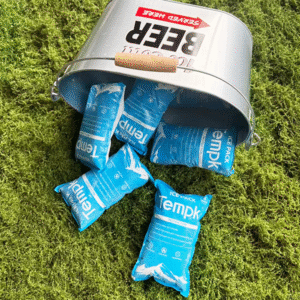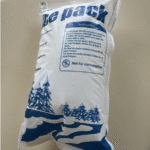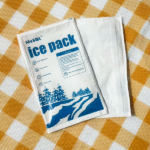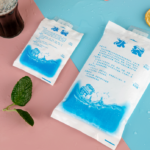Der Versand temperaturempfindlicher Güter ist eine Herausforderung, wenn Lecks und schmelzendes Eis Ihre Produkte ruinieren können. A auslaufsicherer Trockeneisbeutel Hält gefrorene Gegenstände ohne Wasserschäden, fungiert als zuverlässige Kältequelle für Arzneimittel, Meeresfrüchte, Biotechnologie-Proben und Essenslieferungen. In den ersten fünfzig Wörtern dieses Artikels erfahren Sie, was auslaufsichere Packungen von gewöhnlichem Eis unterscheidet, So wählen Sie die richtige Größe für Ihre Sendung aus, und warum 2025 Innovationen machen diese Rucksäcke effizienter und umweltfreundlicher.
Warum auslaufsichere Trockeneisbeutel unerlässlich sind in der modernen Kühlkettenlogistik und wie ihre Struktur Leckagen verhindert.
Wie man auslaufsichere Trockeneisbeutel sicher auswählt und verwendet durch Einhaltung der gesetzlichen Gewichtsgrenzen, richtige Schichtung und Belüftung.
Die Vorteile wiederverwendbarer Trockeneisbeutel und Phasenwechselmaterialien (PCMs) im Vergleich zu herkömmlichen Gelpackungen.
Auftauchen 2025 Trends und Innovationen, einschließlich IoT-Sensoren und nachhaltiger Materialien.
Praxistipps und FAQs um Ihre Sendungen zu optimieren und Kosten zu senken.
Was einen auslaufsicheren Trockeneisbeutel für Kühlkettenlieferungen unerlässlich macht?
Auslaufsichere Trockeneisbeutel schützen empfindliche Produkte, indem sie für langanhaltende Kälte sorgen, ohne Wasser zu produzieren. Im Gegensatz zu nassem Eis, das zu Pfützen schmilzt, Trockeneis sublimiert bei etwa –78,5 °C direkt zu Kohlendioxidgas. Wenn es in einem auslaufsicheren Beutel verpackt ist, Dieses feste CO₂ bleibt auch beim Sublimieren enthalten, Vermeidung von Kreuzkontaminationen und Feuchtigkeitsschäden. Weil kein Wasser heraussickern kann, Diese Packungen sind ideal für Arzneimittel, medizinische Proben und gefrorene Lebensmittel, die während des Transports trocken bleiben müssen.
Den Aufbau auslaufsicherer Trockeneisbeutel verstehen
Auslaufsichere Verpackungen bestehen aus mehreren Schichten. Der äußere Schicht ist in der Regel ein Polyethylen (Pe) Folie oder atmungsaktiver Vliesstoff, der die Festigkeit erhöht und Durchstiche verhindert. Innen, A superabsorbierendes Polymer (SAFT) Schicht absorbiert und bindet Wasser während der Vorhydratisierung. Endlich, A Verbundfolienschicht fungiert als auslaufsichere Barriere. Beim Einweichen in Wasser, Das SAP quillt zu einem Gel auf, das in einem Gefrierschrank gefriert, eine stabile Packung bilden. Dieses mehrschichtige Design verhindert Auslaufen und sorgt für Flexibilität, sodass sich die Verpackung an die Form Ihres Produkts anpassen kann.
Schlüsselvorteile: Waren trocken und kalt halten
| Nutzen | Wie es funktioniert | What It Means for You |
| Kein Wasseraustritt | Trockeneis sublimiert zu CO₂-Gas, anstatt zu einer Flüssigkeit zu schmelzen. | Ihre Produkte bleiben trocken; Etiketten und Verpackung werden nicht durch Kondenswasser oder austretendes Wasser beschädigt. |
| Gleichbleibende ultrakalte Temperatur | Trockeneis bleibt bei etwa –78,5°C, viel kälter als Gel-Packs oder Wassereis. | Ideal zur Konservierung von Impfstoffen, Biologika und Meeresfrüchte, die tiefgekühlt werden müssen. |
| Hohe Festigkeit und Durchstoßfestigkeit | Mehrere Lagen PE- und Verbundfolie schützen die Packung vor dem Einreißen. | Ein geringeres Pannenrisiko beim Versand bedeutet weniger Produktverluste und eine höhere Kundenzufriedenheit. |
| Umweltsicherheit | Die Materialien sind ungiftig und Lecks verursachen keine Umweltverschmutzung. | Sicherere Entsorgung und geringerer ökologischer Fußabdruck im Vergleich zu Gelpackungen, die schädliche Chemikalien enthalten. |
Praktische Tipps für den effektiven Einsatz
Richtig vorhydrieren: Weichen Sie neue Trockeneisbeutel mindestens eine Minute lang in Wasser ein 15 Minuten, um sicherzustellen, dass die SAP-Schicht das Wasser vollständig aufnimmt, bevor sie gefriert.
Vollständig einfrieren: Frieren Sie die hydrierten Packungen ein, bis sie fest sind, bevor Sie sie in Sendungen verladen. Dadurch ist eine maximale Kühlleistung gewährleistet.
Positionieren Sie sich mit Bedacht: Ordnen Sie die Packungen rund um das Produkt an (oder oben platzieren, wenn Sie kalte Luft zum Abstieg benötigen) um die Kälte gleichmäßig zu verteilen. Lassen Sie Platz für das Entweichen von CO₂-Gas, Vermeiden Sie einen Druckaufbau im Inneren des Behälters.
Verwenden Sie isolierte Behälter: Hochwertige Isolierboxen oder Vakuumpaneele verlängern die Lebensdauer von Trockeneis, indem sie die Sublimation verlangsamen.
Tragen Sie Schutzausrüstung: Fassen Sie Trockeneis mit Handschuhen an, um Erfrierungen vorzubeugen und sorgen Sie beim Packen für ausreichende Belüftung.
Fallstudie: Ein Pharmahändler wechselte für Impfstofflieferungen von Gelpackungen zu auslaufsicheren Trockeneispackungen und berichtete über a 20 % Reduzierung der Temperaturschwankungen und 15 % weniger Kundenbeschwerden über beschädigte Verpackungen. Die Fähigkeit von Trockeneis, Produkte gefroren zu halten, ohne kondensationsgeschützte Etiketten zu erzeugen und die Einhaltung gesetzlicher Vorschriften zu gewährleisten.
Wie wählen Sie auslaufsichere Trockeneisbeutel aus und verwenden sie sicher? 2025?
Bei der Auswahl des richtigen Trockeneisbeutels müssen Größe und Gewicht des Beutels an das Volumen der Sendung angepasst werden, Anforderungen an Dauer und Temperatur. Sie sollten ungefähr 1–2 Pfund einkalkulieren (0.5–1 kg) Trockeneis pro 24-Stunden-Versandzeitraum. Für ultrakalte Sendungen (–20 °C bis –70 °C) wie Arzneimittel oder Biotech-Proben, Wählen Sie größere Packungen oder mehrere kleinere Packungen, um die Temperatur aufrechtzuerhalten. Für Lebensmittellieferungen, die Temperaturen knapp unter dem Gefrierpunkt erfordern (–10 °C bis –18 °C), kleinere Packungen reichen aus.
Regulierungs- und Sicherheitsrichtlinien für den Versand mit Trockeneis
Compliance gewährleistet nicht nur eine sichere Lieferung, sondern auch die Vermeidung von Bußgeldern und zurückgewiesenen Sendungen. Gemäß USPS-Verpackungsanweisungen und internationalen Vorschriften, Trockeneis sollte niemals in einem starren Behälter versiegelt werden, luftdichter Behälter. Kohlendioxidgas muss entweichen können, um einen Druckaufbau zu vermeiden. Jedes Paket für den Lufttransport ist auf ca. begrenzt 5 Pfund (2.5 kg) aus Trockeneis; Der Bodentransport kann höhere Mengen ermöglichen. Pakete müssen mit „Trockeneis“ oder „Kohlendioxid fest“ gekennzeichnet sein, UN1845“ und zeigen Sie das Nettogewicht zusammen mit einer Klasse an 9 Hazard -Etikett. Vermeiden Sie es, Trockeneis in versiegelten Plastiktüten oder Metallfässern zu lagern; Verwenden Sie stattdessen stabile Faserplatten, Kunststoff- oder Holzbehälter, die eine Belüftung ermöglichen.
| Versandtyp | Empfohlene Trockeneismenge (pro 24 H) | Temperaturbereich | Regulatorische Hinweise | Bedeutung in der realen Welt |
| Arzneimittel/Impfstoffe | 5–10 Pfund (2.3–4,5 kg) | –20 °C bis –70 °C | Muss den IATA- und DOT-Vorschriften für gefährliche Stoffe entsprechen; für den Lufttransport erforderliche Erklärungen | Gewährleistet extrem kalte Bedingungen für Biologika, ohne die Lesbarkeit oder Wirksamkeit des Etiketts zu beeinträchtigen. |
| Meeresfrüchte/Tiefkühlkost | 1–2 Pfund (0.5–1 kg) | –18 °C bis –20 °C | Markieren Sie Pakete als „Lebensmittel, Gefroren“ und „Trockeneis“., UN1845 ”; Gasentlüftung ermöglichen | Hält Meeresfrüchte frisch und verhindert das Auslaufen von geschmolzenem Eis. |
| Biotech -Proben | 5 lbs (2.3 kg) | –20 °C bis –50 °C | Dokumentieren Sie die Lieferkette und die Einhaltung der Temperaturvorschriften | Bewahrt die Probenintegrität für Forschungs- und Diagnosezwecke. |
| Essenslieferungen | 2–3 Pfund (0.9–1,4 kg) | –10 °C bis –18 °C | Kennzeichnung gemäß den Richtlinien zur Lebensmittelsicherheit; Vermeiden Sie es, gekühlte Artikel einzufrieren | Verhindert das Auftauen von Lebensmitteln und stellt gleichzeitig sicher, dass sie nicht gefrieren und verderben. |
Checkliste zur sicheren Verwendung
Gewicht berechnen: Bestimmen Sie anhand von Volumen und Dauer, wie viel Trockeneis Ihre Sendung benötigt.
Bereiten Sie den Behälter vor: Wählen Sie einen auslaufsicheren Behälter mit Isolierung; Legen Sie Trockeneis auf den Boden oder um die Produkte herum und lassen Sie Platz für die Entlüftung des Gases.
Beschriften und dokumentieren: Markieren Sie die Verpackung mit dem erforderlichen Gefahrenetikett und dem Nettogewicht des Trockeneises; Fügen Sie die Namen des Absenders und des Empfängers hinzu.
Überwachen Sie den Transport: Verwenden Sie IoT-Sensoren, um Temperatur und Standort in Echtzeit zu verfolgen.
Mit Sorgfalt verarbeiten: Tragen Sie isolierte Handschuhe; Platzieren Sie Trockeneis niemals direkt auf der Haut oder in geschlossenen Räumen ohne Belüftung.
Beispiel aus der realen Welt: Ein Biotech-Unternehmen, das genetische Proben international versendet, folgt einem strengen Protokoll: Sie verpacken die Proben in auslaufsicheren Trockeneisbeuteln in einer belüfteten Kartonbox, Markieren Sie das Nettogewicht und UN 1845 Etikett, Setzen Sie einen Temperaturlogger ein und informieren Sie den Spediteur. Durch die Einhaltung der Vorschriften werden Bußgelder vermieden und die Lebensfähigkeit der Proben bei der Ankunft sichergestellt.
Warum sind wiederverwendbare Trockeneisbeutel und PCMs besser als herkömmliche Gelbeutel??
Wiederverwendbare Trockeneisbeutel und Phasenwechselmaterialien (PCMs) sorgen für kontrollierte Temperaturen und reduzieren gleichzeitig Abfall und Kosten. Im Gegensatz zu Einweg-Gelpackungen, die nach ein paar Stunden auslaufen und ihre Wirksamkeit verlieren, PCMs halten Temperaturen zwischen –20 °C und 5 °C für bis zu 72 Std.. Sie verfügen über eine hohe Latentwärmekapazität, die es ihnen ermöglicht, Wärme effizient aufzunehmen und abzugeben, Sie funktionieren wie „intelligente Thermostate“, um Sendungen innerhalb enger Temperaturbereiche zu halten. Moderne wiederverwendbare Verpackungen bestehen aus biologisch abbaubaren Materialien und können hunderte Male wieder eingefroren werden, Reduzierung des Abfalls um bis zu 60 % und die Gesamtversandkosten senken.
Vergleichsmerkmale: Gel-Packs vs. Trockeneis vs. PCM -Packungen
| Kältemitteltyp | Temperaturbereich | Leckrisiko | Umweltauswirkungen | Wiederverwendbarkeit | Praktische Implikation |
| Traditionelle Gelpackungen | 0 ° C bis 10 °C | Mäßig; Gel kann austreten, wenn es durchstochen wird | Enthalten oft Polymere, die schwer zu entsorgen sind | Einmalgebrauch; geringe Wiederverwendbarkeit | Geeignet für Kühlversand; nicht ideal für Frostbedingungen. |
| Trockeneis (Auslaufsichere Packung) | –78,5 °C; ultrakalt | Im versiegelten Zustand minimal; sublimiert zu Gas | CO₂-Emissionen erfordern eine Belüftung; begrenzte Umweltschäden | Zum einmaligen Gebrauch, aber die Verpackung kann wiederverwendet werden | Am besten für Tiefkühlsendungen wie Impfstoffe und Meeresfrüchte geeignet. |
| Phasenwechselmaterial (PCM) | –20 °C bis 5 °C | Vernachlässigbar; Materialien lecken nicht, wenn sie versiegelt sind | Biologisch abbaubare PCMs reduzieren Abfall und CO2-Fußabdruck | Sehr wiederverwendbar; kann hunderte Male wieder eingefroren werden | Ideal für Bereiche von 2–8 °C oder –20 °C; Vermeiden Sie Gefahrenkennzeichnungen und reduzieren Sie den regulatorischen Aufwand. |
Tipps zur Auswahl von PCMs und wiederverwendbaren Trockeneisbeuteln
Passen Sie die Temperaturanforderungen an: Wählen Sie PCMs, die für den Zielbereich Ihres Produkts formuliert sind (Z.B., –20 °C für gefrorene Impfstoffe, 2–8 °C für gekühlte Biologika).
Suchen Sie nach PCM mit hoher Dichte: Packungen mit einer hohen Latentwärmekapazität halten die Kälte länger und minimieren Temperaturschwankungen.
Haltbarkeit prüfen: Strapazierfähige Außenmaterialien und eine durchstichfeste Folie verhindern ein Auslaufen.
Suchen Sie nach Zertifizierungen: Von Behörden wie der FDA oder EU MDR zertifizierte Produkte belegen Sicherheit und Konformität; Sensorintegration reduziert Temperaturabweichungen um 25 %.
Schulung des Personals zur Wiederverwendung: Durch ordnungsgemäße Reinigungs- und Wiedereinfrierverfahren kann die Lebensdauer verlängert werden 500 Zyklen und sparen Tausende pro Einrichtung.
Kundengeschichte: Ein Unternehmen für Essenssets ersetzte Einweg-Gelpackungen durch biologisch abbaubare PCM-Folien und reduzierte den Verpackungsmüll um 60 %. Kombiniert mit IoT-Sensoren, Das Unternehmen reduzierte Temperaturschwankungen um 25 % und über 5.000 US-Dollar pro Vertriebseinrichtung gespart.
Wozu dienen die neuesten Innovationen und Trends bei auslaufsicheren Trockeneisbeuteln? 2025?
Die Kühlkettenbranche entwickelt sich schnell weiter. Intelligente Verpackung und Nachhaltigkeit führen 2025 Innovationen. In Trockeneisbeutel eingebettete IoT-Sensoren liefern Echtzeitdaten zur Temperatur, Luftfeuchtigkeit und Versandort. Diese Sensoren machen Verlader auf Temperaturabweichungen aufmerksam, Ermöglicht Korrekturmaßnahmen, bevor Produkte verderben. Nachhaltige Verpackungsmaterialien – wie biologisch abbaubare PCMs und recycelbare Außenfolien – berücksichtigen Umweltbelange und reduzieren den CO2-Ausstoß. Der globale Markt für Kühlkettenlogistik wird voraussichtlich wachsen $500 Milliarden von 2025, angetrieben durch die Nachfrage nach Biologika und verderblichen Lebensmitteln sowie durch Innovationen bei der Verpackung.
Neueste Fortschritte auf einen Blick
IoT-fähige Überwachung: In die Rucksäcke integrierte Sensoren liefern Echtzeitwarnungen zu Temperatur und Standort. Dies verbessert die Sicht und reduziert den Verderb.
Nachhaltige Materialien: Biologisch abbaubare PCMs und recycelbare Folien reduzieren Abfall und CO2-Fußabdruck. Unternehmen, die diese Materialien einsetzen, reduzieren ihre Emissionen um bis zu 25 %.
KI-gesteuerte Analyse: Algorithmen für maschinelles Lernen analysieren Daten von Sensoren, um Temperaturschwankungen vorherzusagen und das Verpackungsdesign zu optimieren. Einige Firmen nutzen Vorhersagemodelle, um die Eismenge in Echtzeit anzupassen.
Maßgeschneiderte Lösungen: Hersteller bieten maßgeschneiderte Packungsgrößen und PCM-Formulierungen an, die auf bestimmte Temperaturbereiche zugeschnitten sind, Gewährleistung einer präzisen Temperaturregelung.
Marktwachstum und Investitionen: Der Markt für Kühlkettenkältemittel wird voraussichtlich ab USD wachsen 2.01 Milliarden in 2025 in USD 4.28 Milliarden von 2034, eine CAGR von 7.7 %.
Markteinsichten
Die Nachfrage nach auslaufsicheren Trockeneisbeuteln wird durch den weltweit steigenden Arzneimittelverbrauch angeheizt, Biologika und frische Lebensmittel. Online-Lebensmitteldienste und Essenspakete erfordern zuverlässige Kühlkettenlösungen. Gleichzeitig, Regulierungsbehörden und Verbraucher drängen auf umweltfreundliche Verpackungen, Förderung der Einführung wiederverwendbarer PCMs und recycelbarer Materialien. Diese Trends legen nahe, dass weiterhin in intelligente Verpackungen investiert wird, Sensorintegration und nachhaltige Materialien durch 2030.
Häufig gestellte Fragen
Q1: Wie lange hält ein auslaufsicherer Trockeneisbeutel Gegenstände gefroren??
Ein ordnungsgemäß hydrierter und gefrorener Trockeneisbeutel hält die Gegenstände je nach Isolierung und Umgebungstemperatur in der Regel 24 bis 72 Stunden lang gefroren. Für größere Sendungen oder extrem kalte Anforderungen sind möglicherweise zusätzliche Pakete erforderlich.
Q2: Kann ich auslaufsichere Trockeneisbeutel wiederverwenden??
Trockeneis selbst sublimiert und kann nicht wiederverwendet werden, Der auslaufsichere Beutel kann jedoch oft mit Wasser nachgefüllt und wieder eingefroren werden. Für wiederholten Einsatz und geringere Betriebskosten, Denken Sie an PCM-Packungen, die hunderte Male wieder eingefroren werden können.
Q3: Sind auslaufsichere Trockeneisbeutel für Flugreisen sicher??
Ja, vorausgesetzt, Sie befolgen die Vorschriften der Fluggesellschaft und der IATA. Der Rucksack muss eine Gasabgabe ermöglichen und das Nettogewicht sollte die Trockeneisgrenze der Fluggesellschaft nicht überschreiten (häufig 2.5 kg). Ordnungsgemäße Kennzeichnung mit UN 1845 und Gefahrensymbole sind Pflicht.
Q4: Wie entsorge ich gebrauchte Trockeneisbeutel??
Lassen Sie das verbleibende Trockeneis an einem gut belüfteten Ort, fern von Menschen und Haustieren, sublimieren. Recyceln oder entsorgen Sie die Außenmaterialien gemäß den örtlichen Vorschriften; Viele Verpackungen bestehen aus recycelbarem Kunststoff oder biologisch abbaubaren Materialien.
Q5: Warum werden PCMs manchmal Trockeneis vorgezogen??
PCMs bieten kontrollierte Temperaturbereiche (Z.B., 2–8 °C für Kühlgut) ohne Gefahrstoffkennzeichnung oder CO₂-Ausstoß, Dies macht den internationalen Versand einfacher und nachhaltiger.
Q6: Schädigen auslaufsichere Trockeneisbeutel die Umwelt??
Bei korrekter Handhabung und Entsorgung, Trockeneis setzt CO₂ frei, das bereits Teil des industriellen Kreislaufs war, und auslaufsichere Beutel sind oft recycelbar. Neuere PCM-Verpackungen verwenden biologisch abbaubare Materialien und reduzieren den Abfall um bis zu 60 %.
Zusammenfassung und Empfehlungen
Auslaufsichere Trockeneisbeutel sind unschätzbare Hilfsmittel in der modernen Kühlkettenlogistik. Ihr mehrschichtiges Design verhindert Undichtigkeiten, hält Gegenstände trocken, und sorgt für ultrakalte Temperaturen für Arzneimittel, Meeresfrüchte und Biotech-Proben. Die Einhaltung der Verpackungs- und Kennzeichnungsvorschriften gewährleistet einen sicheren Transport und vermeidet Bußgelder. Für Sendungen, die moderate Temperaturen oder Nachhaltigkeit erfordern, PCMs sind wiederverwendbar, umweltfreundliche Alternativen mit hervorragender Temperaturkontrolle. Bleiben Sie informiert über 2025 Innovationen wie IoT-Sensoren und biologisch abbaubare Materialien helfen Ihrem Unternehmen, wettbewerbsfähig zu bleiben.
Umsetzbarer Rat
Bewerten Sie die Temperaturanforderungen Ihres Produkts. Verwenden Sie Trockeneis für Tiefkühlanforderungen und PCMs für gekühlte Bedingungen.
Berechnen Sie die richtige Menge von Trockeneis- oder PCM-Packs anhand von Tabellen wie oben. Seien Sie vorsichtig, um ein Auftauen zu verhindern.
Investieren Sie in intelligente Verpackungen mit integrierten Sensoren zur Überwachung von Temperatur und Standort. Diese Geräte reduzieren den Verderb und das regulatorische Risiko.
Nehmen Sie nachhaltige Materialien an. Entscheiden Sie sich für wiederverwendbare PCM-Verpackungen und recycelbare Folien, um die Umweltbelastung und Abfallkosten zu reduzieren.
Bleib konform. Befolgen Sie die Richtlinien des Transportunternehmens bezüglich der Gewichtsgrenzen für Trockeneis, Kennzeichnung und Belüftung. Schulungspersonal bei sicheren Handhabungsverfahren ausbilden.
Entdecken Sie unsere internen Ressourcen. Besuchen Sie unsere Seiten über wiederverwendbare PCM-Platten, Informieren Sie sich über die Versandvorschriften für Trockeneis und isolierte Versandkartons, um Ihr Wissen zu vertiefen und die besten Kaufentscheidungen zu treffen.
Über Tempk
Bei Tempk, Wir entwickeln fortschrittliche Kühlkettenlösungen, die Ihre Produkte sicher und frisch halten. Unsere auslaufsicheren Trockeneisbeutel, wiederverwendbare PCM-Platten und Isolierbehälter kombinieren Hochleistungsmaterialien mit intelligenter Technologie, um präzise Temperaturen aufrechtzuerhalten. Wir sind stolz auf Nachhaltigkeit, bietet biologisch abbaubare PCMs und recycelbare Verpackungen an, die Abfall und Kohlenstoffemissionen reduzieren. Arbeiten Sie mit uns zusammen um unser Fachwissen in den Bereichen Temperaturkontrolle und Einhaltung gesetzlicher Vorschriften zu nutzen, und stellen Sie sicher, dass Ihre Sendungen genau wie vorgesehen ankommen.
Bereit, Ihre kalte Kette zu optimieren? Kontaktieren Sie unsere Spezialisten für eine maßgeschneiderte Lösung oder fordern Sie noch heute eine kostenlose Beratung an.
























